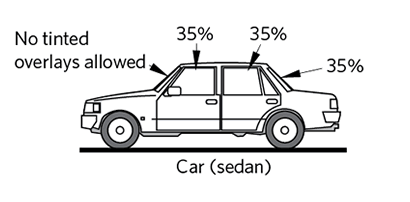The legal requirements for vehicle windows, wipers and mirrors are contained in the Land Transport Rule: Glazing, Windscreen Wipe and Wash, and Mirrors Rule 1999. The purpose of the rule is to set out minimum safety levels to ensure that adequate vision is provided for the driver, and that glazing material is structurally sound and suitable for use in motor vehicles.
The rule covers:
- general safety requirements for vehicle windows (glazing)
- safety standards for windscreen repairs
- glazing standards and trade names that glazing must comply with, including requirements for glazing markings
- window film overlays, stickers and other allowable modifications
- general safety requirements for windscreen wipe and wash systems and rear-view mirrors.
Safety requirements for vehicle windows (glazing)
Glazing must be kept in good condition to ensure the driver can see through the windows clearly and can drive the vehicle safely. Vehicle operators must make sure that:
- the windscreen and front side windows are kept clean and unobstructed
- the windscreen does not have any scratches, discolouration or other defects that impair vision through it
- the glazing is structurally sound and securely fitted to the vehicle.
Windscreen repairs
When a windscreen is damaged, the damage should be repaired as soon as possible to prevent the damage from spreading further and affecting the driver’s vision and the windscreen’s structural strength. A small crack that can be repaired can quickly develop into a large crack that requires the windscreen to be replaced.
The law requires that any windscreen repairs must meet the requirements in the Australian Standard/New Zealand Standard 2366:1999 Windscreen Repairs. The standard specifies the types of damage, the limits to which they can be repaired and the repair methods. The repair invoice must state that the repairs comply with that standard.
Glazing standards
Vehicle windows must have certain properties to ensure structural strength and good driver vision. This is why glazing must comply with approved glazing standards or trade names, as indicated by markings on the glass. Windows originally fitted to vehicles will already comply, depending on the type and age of the vehicle. Replacement windows must also comply with approved standards.
Window film overlays and other allowable modifications
The most common modification to windows is the fitting of tinted or advertising window film overlays. The legal requirements for window film overlays balance road safety issues with the desire of some vehicle owners to put tinted films, advertising or other artwork on their vehicle windows.
The term ‘overlay’ generally refers to self-adhesive or clinging film that is applied to larger areas, or the whole of a window. It can include clear film, tinted film and advertising film. Smaller applications are generally referred to as stickers.
There are restrictions on overlays because they can reduce the driver’s ability to clearly see the road, other road users and potential obstructions.
About VLT
VLT means ‘visible light transmittance’ and is the amount of ‘visible’ light that passes through a vehicle’s windscreen and windows. A clear windscreen has a VLT of approximately 85%, although the VLT can be a low as 70%.
If an overlay is applied to a window, the overall VLT is measured as the amount of light passing through both the glass and the overlay. This means that if a tinted film overlay of 35% VLT is applied to a front side window that already has 70% VLT, the overall VLT will be well below 35%.
The overall VLT is checked by using a calibrated VLT meter. Most vehicle testing stations have a VLT meter so you should see them or a reputable window film installer if you would like to have the VLT of your tinted windows measured (get written confirmation of the overall VLT from the installer if you need to).
Note that VLT measurements are only relevant to transparent (clear or tinted) overlays. VLT is not an appropriate measurement for non-transparent overlays, such as printed or perforated advertising film.
Where can I have transparent film overlays applied?
Windscreens
The only overlays allowed on windscreens are:
- anti-glare bands that extend no lower than the bottom of the sun visors when folded against the windscreen (no print allowed below 100mm from the top of the windscreen)
- stone guards overlay on goods vehicles and buses fitted no higher than the top of the steering wheel.
Front side windows
‘Front side windows’ means the windows on either side of the driver’s seat. Front side windows fitted with transparent overlays must have an overall VLT of at least 35%.
Rear windows (windows behind the driver’s seat)
A transparent overlay applied to a rear window of a car (sedan, station wagon, hatchback, sports car or convertible) must have an overall VLT of at least 35%.
An overlay fitted to a rear window of any other vehicle, including a stretch limousine and body transfer vehicle, may be of any tint level.
Any vehicle with an overlay applied to a rear window must have an external rear view mirror on each side.
Examples – minimum VLT limits for tinted overlays for different vehicles
Fitting non-transparent film, perforated overlays and stickers
Any sticker, film overlay or print that is not transparent, such as an advertising or perforated overlay, may only be fitted in certain areas.
- On the windscreen – it must be completely within 100mm from the top or bottom edge of the windscreen or within 50mm from the side edge of the windscreen.
- On a front side window – it must be completely within 100mm from the bottom edge of the window or within 50mm from the top or side edges
- On a rear window of a car (sedan, station wagon, hatchback, sports car, convertible) – it must be completely within 100mm from any edge of the window.
- On a rear window of any other vehicle – it can be fitted anywhere.
What else can I put on my vehicle’s windows?
You can fit a radio antenna to any window, as long as it’s within 100mm from any edge of the glazing. On a vehicle other than a car, a radio antenna may also be fitted anywhere on a rear window of a vehicle.
You can have an electrically-heated demister unit on a rear window.
Other requirements that apply to modified glazing
Modifications, such as stickers and overlays, must not have a mirrored effect sufficient to dazzle other road users.
The performance of a central high-mounted stop lamp must not be affected by the modification.
Any modification that meets the legal requirements above but has unreasonably reduced the driver’s vision through the windscreen and front side windows is not allowed.
Windscreen wash and wipe systems
The law says that a vehicle’s windscreen wash and wipe systems must keep the windscreen clean and clear enough for the driver to be able to drive safely at all times and under all weather conditions.
Agricultural vehicles with windscreens must have a windscreen wipe system. Agricultural vehicles manufactured on or after 1 January 2001 also need to have a windscreen wash system, unless this requirement is inappropriate for the use of the vehicle.
Rear-view mirrors
The law sets out general safety requirements for a vehicle’s rear-view mirrors. These requirements apply to original and replacement mirrors. They must:
- be adjustable
- be attached securely
- provide the driver with an adequate view of the rear of the vehicle and its load, and of any trailer and load the vehicle tows.
How many mirrors do I need?
The law sets out how many and what type of rear-view mirrors must at least be fitted to a vehicle, depending on the vehicle’s type and age:
| Type of vehicle | Vehicle manufactured before 1/1/2000 | Vehicle manufactured on or after 1/1/2000 |
|---|---|---|
| Passenger cars | one right-hand outside or one interior mirror | one right-hand outside and one interior mirror |
| Light goods vehicles | one right-hand outside or one interior mirror | either one right-hand outside and one interior, or one right-hand outside and one left-hand outside mirror |
| Mopeds | no requirement | one mirror |
| Motorcycles/trikes | one mirror | one mirror |
| Buses and heavy goods vehicles | one right-hand and one left-hand mirror | one right-hand outside mirror and one left-hand outside mirror |
| All other vehicles (except motorised pedal cycles and trailers) | one mirror | one mirror |
Where you can find out more
The legal requirements for windscreens and windows are set out in Land Transport Rule: Glazing, Windscreen Wipe and Wash, and Mirrors 1999, as amended by Land Transport Rule: Glazing, Windscreen Wipe and Wash, and Mirrors Amendment 2005 and the Land Transport Rule: Glazing, Windscreen Wip and Wash, and Mirrors Amendment 2007.








